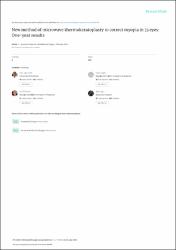New method of microwave thermokeratoplasty to correct myopia in 33 eyes: One-year results

Göster/
Tarih
2013Yazar
Çelik, UğurAlagöz, Neşe
Yıldırım, Yusuf
Ağca, Alper
Marshall, John
Muller, David
Yılmaz, Ömer Faruk
Üst veri
Tüm öğe kaydını gösterÖzet
PURPOSE: To assess the safety, predictability, and stability of a new microwave thermokeratoplasty procedure to correct myopia. SETTING: Cornea and refractive surgery subspecialty. DESIGN: Prospective clinical trial. METHOD: Thermokeratoplasty was performed in myopic eyes at a single center in Turkey from June 2009 to June 2010. The attempted corrections ranged from -1.25 to -5.75 diopters (D). The main outcome measures were changes in logMAR uncorrected distance visual acuity (UDVA) and in keratometry (K) values. RESULTS: The procedure was performed in 33 eyes (patients aged 20 to 45 years). The mean preoperative logMAR UDVA (0.76 +/- 0.24 [SD]) significantly improved to 0.19 +/- 0.20 at 1 month, postoperatively. By 3 months, the mean UDVA had markedly regressed to 0.59 +/- 0.29; however, the residual improvement remained statistically significant. At 12 months, the mean logMAR UDVA was 0.72 +/- 0.26. The mean K values were 43.9 +/- 1.36 D preoperatively, 41.25 +/- 2.63 D at 1 month, 43.4 +/- 1.69 D at 3 months, and 44.1 +/- 1.09 D at 12 months. The mean endothelial cell density was 2836 +/- 342 cells/mm(2) preoperatively and were statistically unchanged 12 months postoperatively (2732 +/- 353 cell/mm(2)). No patient lost lines of corrected distance visual acuity by 12 months postoperatively. CONCLUSIONS: The new thermokeratoplasty procedure produced the desired reduction in myopia and improvement in postoperative UDVA 1 month postoperatively without significant side effects. However, early and complete regression shows the need for further development of this technique.

















